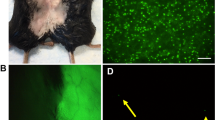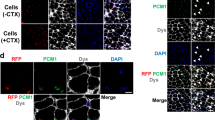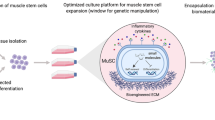Abstract
In muscle, mutant genes can be targeted and corrected directly by intramuscular (i.m.) injection of corrective DNA, or by ex vivo delivery of DNA to myogenic cells, followed by cell transplantation. Short fragment homologous replacement (SFHR) has been used to repair the exon 23 nonsense transition at the Xp21.1 dys locus in cultured cells and also, directly in tibialis anterior from male mdx mice. Whilst mdx dys locus correction can be achieved in up to 20% of cells in culture, much lower efficiency is evident by i.m. injection. The major consideration for application of targeted gene correction to muscle is delivery throughout relevant tissues. Systemically injected bone marrow (BM)-derived cells from wt C57BL/10 ScSn mice are known to remodel mdx muscle when injected into the systemic route. Provided that non muscle-derived cell types most capable of muscle remodeling activity can be more specifically identified, isolated and expanded, cell therapy seems presently the most favorable vehicle by which to deliver gene correction throughout muscle tissues. Using wt bone marrow as a model, this study investigates systemic application of bone marrow-derived cells as potential vehicles to deliver corrected (ie wt) dys locus to dystrophic muscle. Intravenous (i.v.) and intraperitoneal (i.p.) injections of wt BM were given to lethally and sub-lethally irradiated mdx mice. Despite both i.v. and surviving i.p. groups containing wt dys loci in 100% and less than 1% of peripheral blood nuclei, respectively, both groups displayed equivalent levels of wt dys transcript in muscle RNA. These results suggest that the muscle remodeling activity observed in systemically injected BM cells is not likely to be found in the hemopoietic fraction.
This is a preview of subscription content, access via your institution
Access options
Subscribe to this journal
Receive 12 print issues and online access
$259.00 per year
only $21.58 per issue
Buy this article
- Purchase on Springer Link
- Instant access to full article PDF
Prices may be subject to local taxes which are calculated during checkout



Similar content being viewed by others
Change history
03 February 2021
A Correction to this paper has been published: https://doi.org/10.1038/s41434-020-00217-7
References
Gussoni E et al. Dystrophin expression in the mdx mouse restored by stem cell transplantation Nature 1999 401: 390–394
Bittner RE et al. Recruitment of bone marrow-derived cells by skeletal and cardiac muscle in adult dystrophic mdx mice Anat Embryol (Berl) 1999 199: 391–396
Rando TA, Disatnik MH, Zhou LZ . Rescue of dystrophin expression in mdx mouse muscle by RNA/DNA oligonucleotides Proc Natl Acad Sci USA 2000 97: 5353–5368
Kapsa R et al. In vivo and in vitro correction of the mdx dystrophin gene nonsense mutation by short-fragment homologous replacement Hum Gene Ther 2001 12: 629–642
Bertoni C, Rando TR . Restoration of dystrophin expression in mdx myoblasts by chimeric DNA/RNA oligonucleotides Neuromusc Dis 2001 6/7: 663
Huard J et al. High efficiency of muscle regeneration after human myoblast clone transplantation in SCID mice J Clin Invest 1994 93: 586–599
Vilquin JT et al. Successful histocompatible myoblast transplantation in dystrophin-deficient mdx mouse despite the production of antibodies against dystrophin J Cell Biol 1995 131: 975–988
Vilquin JT et al. Successful histocompatible myoblast transplantation in dystrophin-deficient mdx mouse despite the production of antibodies against dystrophin Kapsa RMI et al. PCR Based Methods for resolution of wt Dystrophin loci from mdx loci in the mdx mouse model of Duchenne muscular dystrophy. Mutat Res (submitted)
Lee JY et al. Clonal isolation of muscle-derived cells capable of enhancing muscle regeneration and bone healing J Cell Biol 2000 150: 1085–1100
Bower J et al. The role of growth factors in myoblast transfer therapy Bas App Myol 1997 7: 177–186
Austin L et al. Leukemia inhibitory factor ameliorates muscle fiber degeneration in the mdx mouse Muscle Nerve 2000 23: 1700–1705
White JD, Bower JJ, Kurek JB, Austin L . Leukemia inhibitory factor enhances regeneration in skeletal muscles after myoblast transplantation Muscle Nerve 2001 24: 695–697
Acknowledgements
The authors gratefully acknowledge the assistance rendered through funding contributions for the research presented in this communication from the MDA (Australia), NHMRC (Australia), MDA (USA), AFM (France).
Author information
Authors and Affiliations
Rights and permissions
About this article
Cite this article
Kapsa, R., Quigley, A., Vadolas, J. et al. Targeted gene correction in the mdx mouse using short DNA fragments: towards application with bone marrow-derived cells for autologous remodeling of dystrophic muscle. Gene Ther 9, 695–699 (2002). https://doi.org/10.1038/sj.gt.3301737
Published:
Issue Date:
DOI: https://doi.org/10.1038/sj.gt.3301737
Keywords
This article is cited by
-
The Gene Targeting Approach of Small Fragment Homologous Replacement (SFHR) Alters the Expression Patterns of DNA Repair and Cell Cycle Control Genes
Molecular Therapy - Nucleic Acids (2016)
-
Branched oligonucleotides induce in vivo gene conversion of a mutated EGFP reporter
Gene Therapy (2003)



